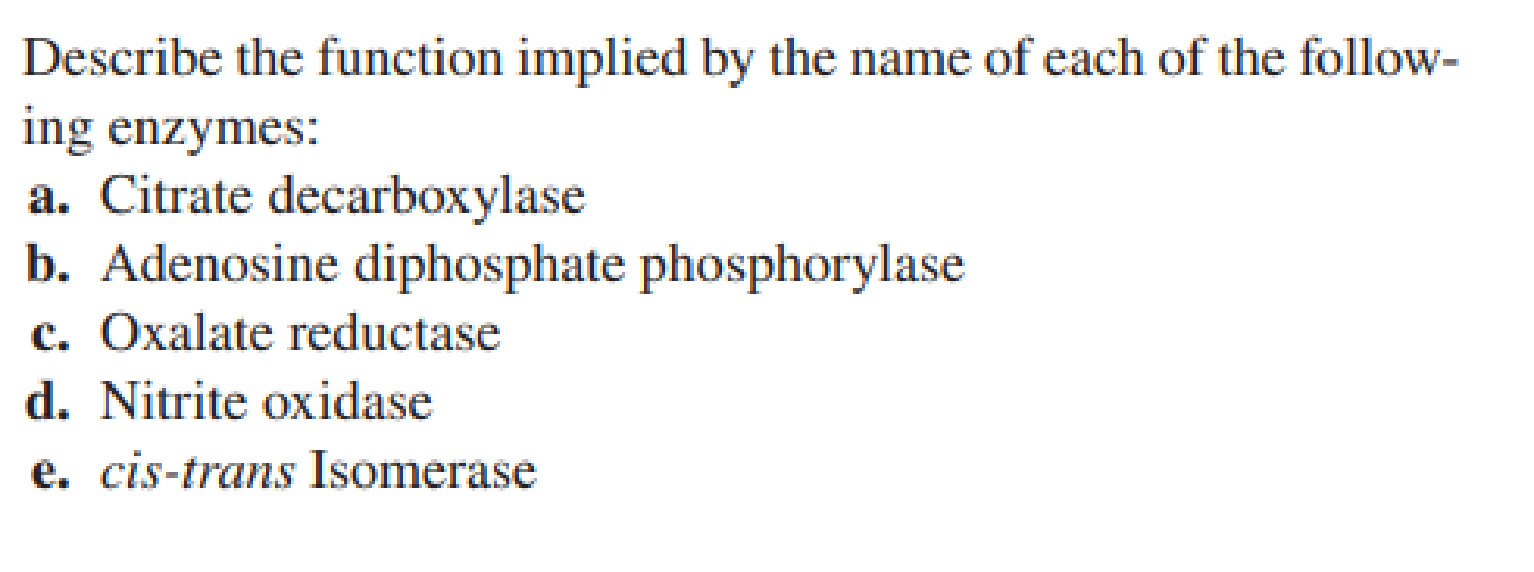
Concept explainers
(a)
Interpretation:

The function implied by the enzyme citrate decarboxylase has to be given.
Concept Introduction:
The enzymes are essentially the biocatalysts present in all living systems. Each enzyme catalyzes a characteristic reaction within the biological system. Enzymes on the basis of the substrate on which they act or the reaction that they catalyze can be classified into six classes.
Based on their specific role they are classified into six major classes. These are:
- Ligases: The enzymes that connect two molecules via covalent bonds are termed as ligases.
- Isomerases: The enzymes that catalyze the isomerization reactions are termed as isomerases.
- Lyases: Enzymes that catalyze the cleavage of bonds are called lyases.
- Hydrolases: These enzymes catalyze the cleavage of bonds via hydrolysis present in biological systems.
- Transferases: These enzymes are involved in the transfer of various
functional groups such as methyl, acetyl group, or phosphate group. - Oxidoreductases: As the name suggests, these catalyze the
oxidation and reduction reactions that occur in living systems.
Enzymes are often named in accordance with the substrate on which they act. For example, lactase acts on the disaccharide named lactose and helps to remove the glycosidic linkages of lactose.
(b)
Interpretation:
The function implied by the enzyme adenosine diphosphate phosphorylase has to be given.
Concept Introduction:
Refer to part (a).
(c)
Interpretation:
The function implied by enzyme oxalate reductase has to be given.
Concept Introduction:
Refer to part (a).
(d)
Interpretation:
The function implied by the enzyme nitrite oxidase has to be given.
Concept Introduction:
Refer to part (a).
(e)
Interpretation:
The function implied by the enzyme cis-trans isomerase has to be given.
Concept Introduction:
Refer to part (a).
Want to see the full answer?
Check out a sample textbook solution
Chapter 19 Solutions
GEN ORGANIC CHM LL W/CONNECT
- Can I please get help with this?arrow_forwardUse the Henderson-Hasselbalch equation to calculate pH of a buffer containing 0.050M benzoic acidand 0.150M sodium benzoate. The Ka of benzoic acid is 6.5 x 10-5arrow_forwardA. Draw the structure of each of the following alcohols. Then draw and name the product you would expect to produce by the oxidation of each. a. 4-Methyl-2-heptanol b. 3,4-Dimethyl-1-pentanol c. 4-Ethyl-2-heptanol d. 5,7-Dichloro-3-heptanolarrow_forward
- What is the pH of a 1.0 L buffer made with 0.300 mol of HF (Ka = 6.8 × 10⁻⁴) and 0.200 mol of NaF to which 0.160 mol of NaOH were added?arrow_forwardCan I please get help with this.arrow_forwardDetermine if the following salt is neutral, acidic or basic. If acidic or basic, write the appropriate equilibrium equation for the acid or base that exists when the salt is dissolved in aqueous solution. If neutral, simply write only NR. Be sure to include the proper phases for all species within the reaction. N₂H₅ClO₄arrow_forward
 ChemistryChemistryISBN:9781305957404Author:Steven S. Zumdahl, Susan A. Zumdahl, Donald J. DeCostePublisher:Cengage Learning
ChemistryChemistryISBN:9781305957404Author:Steven S. Zumdahl, Susan A. Zumdahl, Donald J. DeCostePublisher:Cengage Learning ChemistryChemistryISBN:9781259911156Author:Raymond Chang Dr., Jason Overby ProfessorPublisher:McGraw-Hill Education
ChemistryChemistryISBN:9781259911156Author:Raymond Chang Dr., Jason Overby ProfessorPublisher:McGraw-Hill Education Principles of Instrumental AnalysisChemistryISBN:9781305577213Author:Douglas A. Skoog, F. James Holler, Stanley R. CrouchPublisher:Cengage Learning
Principles of Instrumental AnalysisChemistryISBN:9781305577213Author:Douglas A. Skoog, F. James Holler, Stanley R. CrouchPublisher:Cengage Learning Organic ChemistryChemistryISBN:9780078021558Author:Janice Gorzynski Smith Dr.Publisher:McGraw-Hill Education
Organic ChemistryChemistryISBN:9780078021558Author:Janice Gorzynski Smith Dr.Publisher:McGraw-Hill Education Chemistry: Principles and ReactionsChemistryISBN:9781305079373Author:William L. Masterton, Cecile N. HurleyPublisher:Cengage Learning
Chemistry: Principles and ReactionsChemistryISBN:9781305079373Author:William L. Masterton, Cecile N. HurleyPublisher:Cengage Learning Elementary Principles of Chemical Processes, Bind...ChemistryISBN:9781118431221Author:Richard M. Felder, Ronald W. Rousseau, Lisa G. BullardPublisher:WILEY
Elementary Principles of Chemical Processes, Bind...ChemistryISBN:9781118431221Author:Richard M. Felder, Ronald W. Rousseau, Lisa G. BullardPublisher:WILEY





